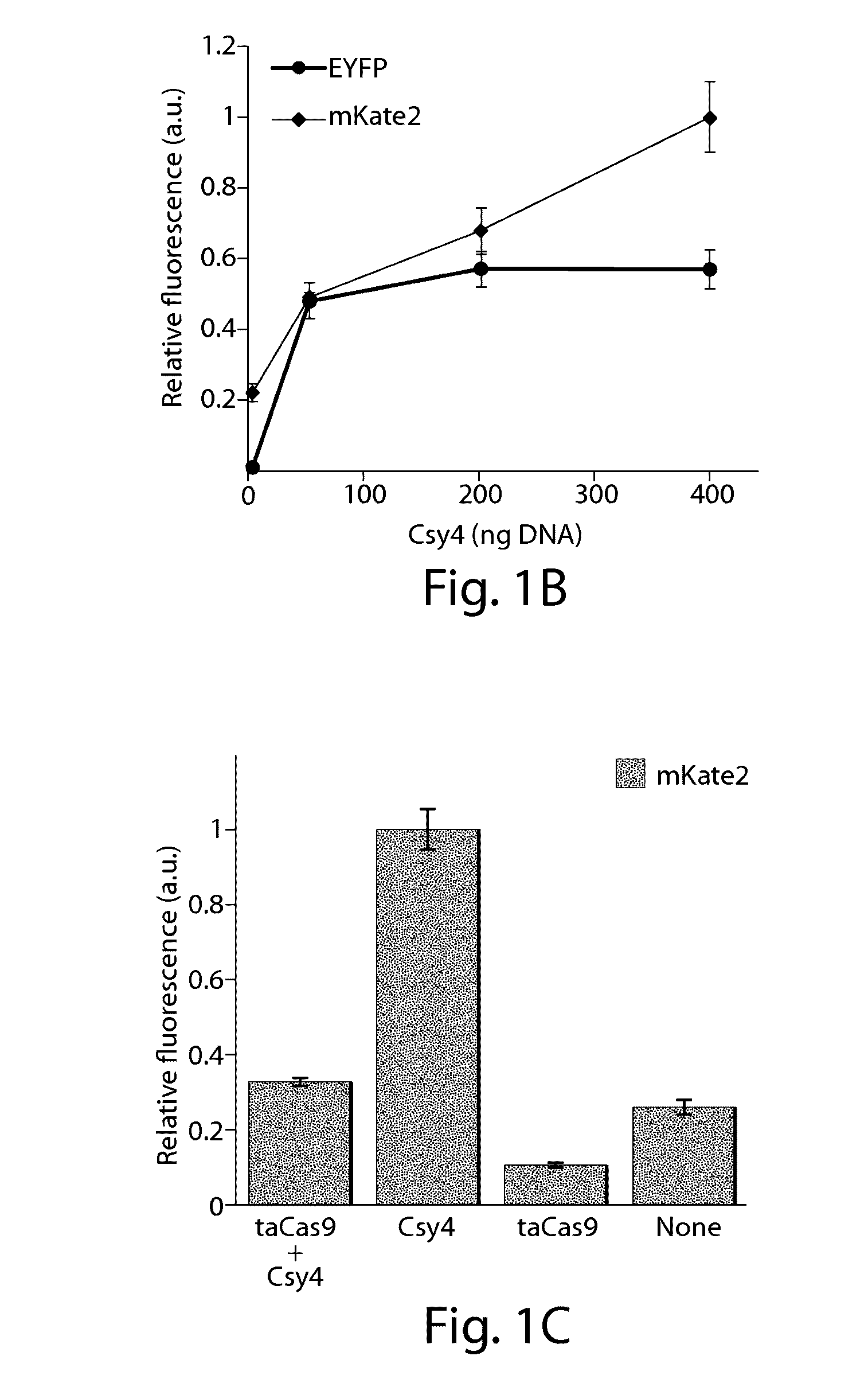Methods and compositions for the production of guide RNA
a technology of guide rna and composition, applied in the field of transcriptional regulation and synthetic biology, to achieve the effect of efficient modulation of synthetic constructs
- Summary
- Abstract
- Description
- Claims
- Application Information
AI Technical Summary
Benefits of technology
Problems solved by technology
Method used
Image
Examples
example 1
Functional gRNA Generation with an RNA Triple Helix and Csy4
[0160]An important first step to enabling complex CRISPR-TF-based circuits is to generate functional gRNAs from RNAP II promoters in human cells, which permits coupling of gRNA production to specific regulatory signals. For example, the activation of gRNA-dependent circuits can be initiated in defined cell types or states, or in response to external inputs. Furthermore, the ability to simultaneously express gRNAs along with proteins from a single transcript is beneficial. This enables multiple outputs, including effector proteins and regulatory links, to be produced from a concise genetic configuration. It can also enable the integration of gRNA expression into endogenous loci. Thus, the present Example demonstrates a system in which functional gRNAs and proteins are simultaneously produced by endogenous RNAP II promoters.
[0161]The RNA-binding and RNA-endonuclease capabilities of the Csy4 protein from P. aeruginosa (Haurwit...
example 2
Modulating Endogenous Loci with CRISPR-TFs Expressed from Human Promoters
[0167]To validate the robustness of the ‘triplex / Csy4’ configuration, it was adapted to regulate the expression of a native genomic target in human cells. The endogenous IL1RN locus was targeted for gene activation via the co-expression of four distinct gRNAs, gRNA3-6 (Table 1) (Perez-Pinera et al., 2013a).
TABLE 1Sequences used in the studySequence (Kozak sequence and startNamecodon underlined)dCas9-3xNLS-GCCACCATGGACAAGAAGTACTCCATTGGGCTCGCCATCGGCAVP64-3′LTRCAAACAGCGTCGGCTGGGCCGTCATTACGGACGAGTACAAGG(Construct 1)TGCCGAGCAAAAAATTCAAAGTTCTGGGCAATACCGATCGCCACAGCATAAAGAAGAACCTCATTGGCGCCCTCCTGTTCGACTCCGGGGAGACGGCCGAAGCCACGCGGCTCAAAAGAACAGCACGGCGCAGATATACCCGCAGAAAGAATCGGATCTGCTACCTGCAGGAGATCTTTAGTAATGAGATGGCTAAGGTGGATGACTCTTTCTTCCATAGGCTGGAGGAGTCCTTTTTGGTGGAGGAGGATAAAAAGCACGAGCGCCACCCAATCTTTGGCAATATCGTGGACGAGGTGGCGTACCATGAAAAGTACCCAACCATATATCATCTGAGGAAGAAGCTTGTAGACAGTACTGATAAGGCTGACTTGCGGTTGATCTATCTCGCGCTGGCGCATATGATC...
example 3
Functional gRNA Generation from Introns with Csy4
[0171]As a complement to the ‘triplex / Csy4’ configuration, an alternative strategy was developed for generating functional gRNAs from RNAP II promoters by encoding a gRNA within an intron in the coding sequence of a gene. Specifically, gRNA1 was encoded as an intron within the coding sequence of mKate2 (FIG. 2A) using ‘consensus’ acceptor, donor, and branching sequences (Smith et al., 1989; Taggart et al., 2012). Unexpectedly, this simple configuration resulted in undetectable EYFP levels (FIG. 10, bottom panel). Without being bound by theory, without any stabilization, intronic gRNAs appears to be rapidly degraded. To stabilize intronic gRNAs, intronic sequences that produce long-lived introns were used. These included sequences such as the HSV-1 latency associated intron, which forms a stable circular intron (Block and Hill, 1997), and the sno-lncRNA2 (snoRNA2) intron. The snoRNA2 intron is processed on both ends by the snoRNA machi...
PUM
| Property | Measurement | Unit |
|---|---|---|
| temperature | aaaaa | aaaaa |
| length | aaaaa | aaaaa |
| triple helix structure | aaaaa | aaaaa |
Abstract
Description
Claims
Application Information
 Login to View More
Login to View More - R&D
- Intellectual Property
- Life Sciences
- Materials
- Tech Scout
- Unparalleled Data Quality
- Higher Quality Content
- 60% Fewer Hallucinations
Browse by: Latest US Patents, China's latest patents, Technical Efficacy Thesaurus, Application Domain, Technology Topic, Popular Technical Reports.
© 2025 PatSnap. All rights reserved.Legal|Privacy policy|Modern Slavery Act Transparency Statement|Sitemap|About US| Contact US: help@patsnap.com



